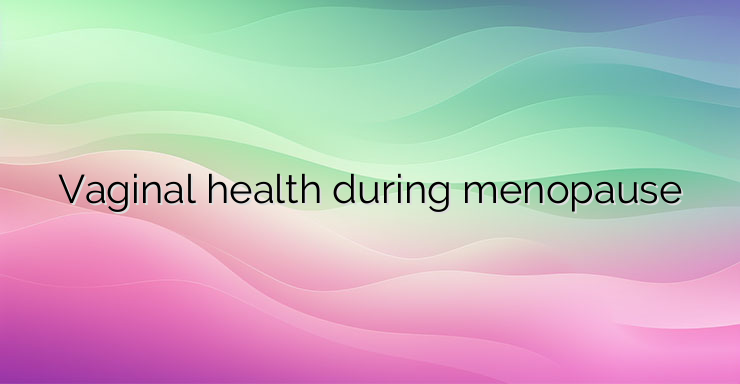The state of hypoestrogenism associated with menopause has a strong negative impact on vaginal and urinary health, often leading to a condition called genitourinary syndrome. Genitourethral syndrome is associated with genital signs and symptoms such as dryness, burning, irritation and discomfort or pain during intercourse and impaired sexual function. This condition, formerly known as vulvovaginal atrophy, may also be accompanied by urinary signs and symptoms such as urinary incontinence, dysuria, stranguria, and frequent urinary tract infections. Unlike other menopausal symptoms, vulvovaginal atrophy is a chronic condition that tends to worsen in the years after menopause. Therefore, it requires rapid and long-term therapy to achieve good results and to avoid the recurrence of symptoms when treatment is stopped. This condition has important consequences in the daily lives of postmenopausal women and in their relationships. Given that women spend a third of their lives in menopause, it is essential to recognize and treat this syndrome in order to restore the vaginal and vulvar epithelium and ultimately improve quality of life. The rationale for treatment is to restore normal vaginal and vulvar physiology, leading to symptom relief. Many options have been developed over the years, such as topical, systemic hormonal and non-hormonal treatments, or energy-based treatments, which could potentially meet the needs and preferences of most women, thereby improving the quality of life of postmenopausal women. Vulvovaginal atrophy affects most peri- and postmenopausal women with a prevalence ranging from 36% to almost 90%, according to the most recent studies. It has recently been reported that this condition is now also present in the premenopausal years with a prevalence of 19% in women aged 40-45 years. Despite its high prevalence, vaginal atrophy is still underdiagnosed and undertreated. Most women do not discuss their symptoms with their gynecologist for a variety of reasons. Often because they believe it’s just a natural part of aging or because they’re embarrassed to talk about it. Often they are not aware that there is a treatment for the syndrome. Whatever the reason, lack of diagnosis still remains one of the major problems in the care of this condition. A decline in circulating hormone levels, especially estrogen, is the main trigger that determines vulvovaginal atrophy. The vaginal epithelium of postmenopausal women shows flattened epithelial surfaces with features of keratinization and absence of papillae. Multiple layers of parabasal cells with a higher nucleus-to-cytoplasm ratio and a few intermediate and superficial cells are present in which glycogen stores are reduced. This leads to a decrease in the number of lactobacilli, which is associated with an increase in vaginal pH.The low percentage of lactobacilli and the increase in the relative proportion of anaerobic bacteria found in postmenopausal women may predispose to symptomatic vulvovaginal atrophy, although not all studies have consistently reported this relationship. Hypoestrogenic vaginal conditions also usually include changes in connective tissue composition with a reduced type I/III collagen ratio, resulting in reduced tissue strength. Clinical signs at the vaginal level include everything from dryness and insufficient hydration, redness, loss of elasticity, petechiae, ulceration, inflammation, atypical discharge, to fibrosis and vaginal effacement. The most common signs at the vulva level include a decrease in tissue thickness, agglutination of the labia, loss of pubic hair, and lesions from scratching due to pruritus. Subsequent symptoms include vaginal dryness and superficial dyspareunia. References: 1. Portman DJ, Gass ML Vulvovaginal Atrophy Terminology Consensus Conference Panel. Genitourinary syndrome of menopause: New terminology for vulvovaginal atrophy from the International Society for the Study of Women’s Sexual Health and the North American Menopause Society. Climacteric. 2. Gandhi J., Chen A., Dagur G., Suh Y., Smith N., Cali B., Khan SA Genitourinary syndrome of menopause: An overview of clinical manifestations, pathophysiology, etiology, evaluation, and management. Am. J. Obstet. Gynecol 3. Palacios S., Castelo-Branco C., Currie H., Mijatovic V., Nappi RE, Simon J., Rees M. Update on management of genitourinary syndrome of menopause: A practical guide. Maturitas.etiology, evaluation, and management. Am. J. Obstet. Gynecol 3. Palacios S., Castelo-Branco C., Currie H., Mijatovic V., Nappi RE, Simon J., Rees M. Update on management of genitourinary syndrome of menopause: A practical guide. Maturitas.etiology, evaluation, and management. Am. J. Obstet. Gynecol 3. Palacios S., Castelo-Branco C., Currie H., Mijatovic V., Nappi RE, Simon J., Rees M. Update on management of genitourinary syndrome of menopause: A practical guide. Maturitas.


Leave a Reply